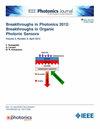基于单像素点展函数和深度学习的轴向密集发射器定位技术
IF 2.4
4区 工程技术
Q3 ENGINEERING, ELECTRICAL & ELECTRONIC
引用次数: 0
摘要
受激发射损耗显微镜(STED)采用的逐点三维扫描策略非常耗时。在非衍射贝塞尔-贝塞尔 STED(BB-STED)中,可以用二维扫描取代三维扫描。为了在 BB-STED 中提取受激发射体的轴向信息,我们建议使用具有单螺旋 PSF 的探测光路对轴向信息进行编码,然后通过深度学习预测发射体的深度。仿真表明,对于深度范围为 4 µm 的密集发射体,轴向精度可以达到 ∼ 35 nm。我们的方法也适用于实验数据,轴向精度可达 ∼63 nm。本文章由计算机程序翻译,如有差异,请以英文原文为准。
Localizing Axial Dense Emitters Based on Single-Helix Point Spread Function and Deep Learning
The point-by point 3D scanning strategy adopted in Stimulated Emission Depletion Microscopy (STED) is time-consuming. The 3D scanning can be replaced with a 2D scanning in the non-diffracting Bessel-Bessel STED (BB-STED). In order to extract the excited emitters’ axial information in BB-STED, we propose to encode axial information by using a detection optical path with single-helix PSF, and then predict the depths of the emitters with deep learning. Simulation demonstrated that, for dense emitters in a depth range of 4 µm, an axial precision of ∼35 nm can be achieved. Our method also works for experimental data, and an axial precision of ∼63 nm can be achieved.
求助全文
通过发布文献求助,成功后即可免费获取论文全文。
去求助
来源期刊

IEEE Photonics Journal
ENGINEERING, ELECTRICAL & ELECTRONIC-OPTICS
CiteScore
4.50
自引率
8.30%
发文量
489
审稿时长
1.4 months
期刊介绍:
Breakthroughs in the generation of light and in its control and utilization have given rise to the field of Photonics, a rapidly expanding area of science and technology with major technological and economic impact. Photonics integrates quantum electronics and optics to accelerate progress in the generation of novel photon sources and in their utilization in emerging applications at the micro and nano scales spanning from the far-infrared/THz to the x-ray region of the electromagnetic spectrum. IEEE Photonics Journal is an online-only journal dedicated to the rapid disclosure of top-quality peer-reviewed research at the forefront of all areas of photonics. Contributions addressing issues ranging from fundamental understanding to emerging technologies and applications are within the scope of the Journal. The Journal includes topics in: Photon sources from far infrared to X-rays, Photonics materials and engineered photonic structures, Integrated optics and optoelectronic, Ultrafast, attosecond, high field and short wavelength photonics, Biophotonics, including DNA photonics, Nanophotonics, Magnetophotonics, Fundamentals of light propagation and interaction; nonlinear effects, Optical data storage, Fiber optics and optical communications devices, systems, and technologies, Micro Opto Electro Mechanical Systems (MOEMS), Microwave photonics, Optical Sensors.
 求助内容:
求助内容: 应助结果提醒方式:
应助结果提醒方式:


